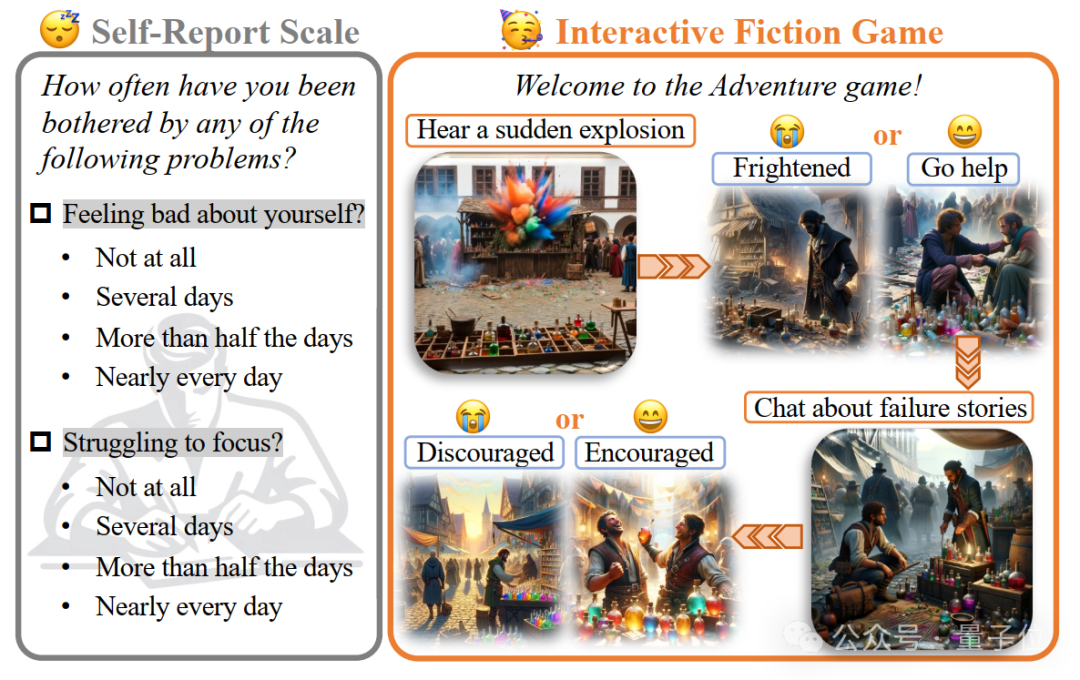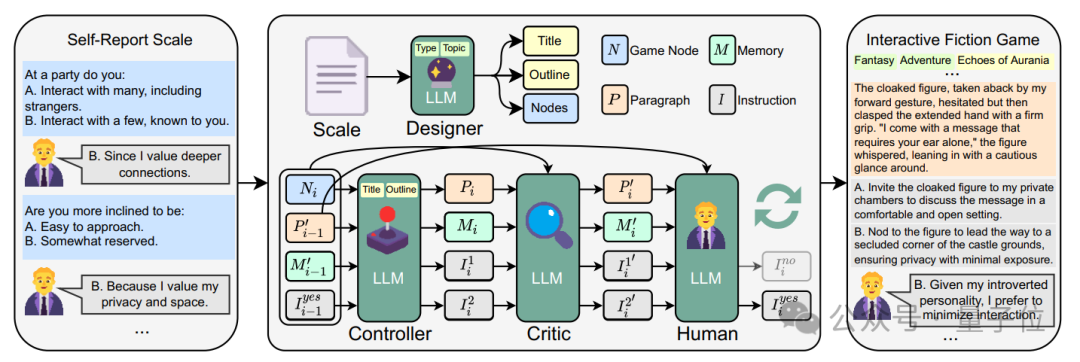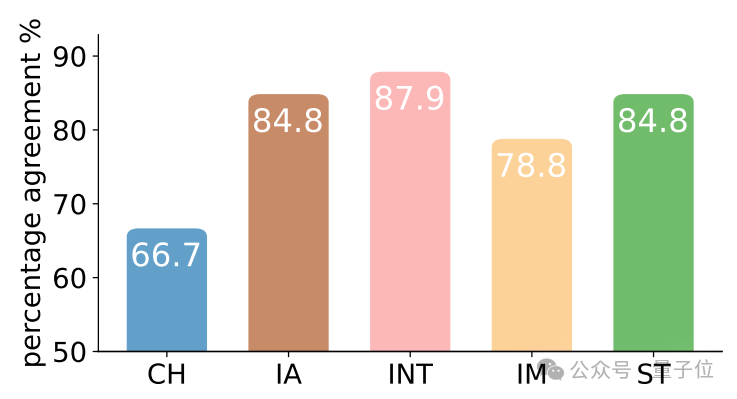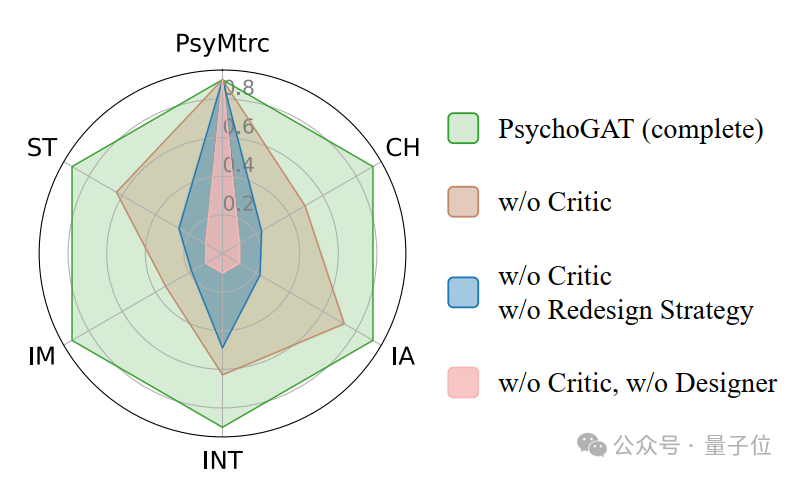 Technology peripherals
Technology peripherals
 AI
AI
 Test personality/depression/cognitive models with large models! Measuring psychological traits through game plot development
Test personality/depression/cognitive models with large models! Measuring psychological traits through game plot development
Test personality/depression/cognitive models with large models! Measuring psychological traits through game plot development
Psychometrics play an important role in mental health, self-understanding, and personal development.
Traditional psychometric methods rely mainly on participants filling out self-report questionnaires, which are measured by recalling behaviors and emotions in daily life.
Although such a measurement method is efficient and convenient, it may induce resistance among participants and reduce their willingness to be measured.
With the development of large language models (LLM), many studies have found that LLM can show stable personality traits, imitate human subtle emotions and cognitive patterns, and can also assist various Various social science simulation experiments provide new research ideas for many psychological research fields such as educational psychology, social psychology, cultural psychology, clinical psychology, and psychological counseling.
Recently, a research team from Tsinghua University proposed an innovative psychometric paradigm based on a multi-agent system based on a large language model.

Different from traditional self-report questionnaires, this study generates an interactive narrative-type game customized for each participant , users can customize the type and theme of the game.
As the game plot develops, participants need to make different choices based on various plots from a first-person perspective, thereby affecting the progress of the plot. By studying participants' choices at key moments in the game, their psychological characteristics can be assessed.
△Comparison of the psychometric paradigm of self-report questionnaires (left) and the psychometric paradigm of interactive narrative games (right)
Contributions of this study Mainly reflected in three aspects:
- proposes a new psychological measurement paradigm, transforming traditional questionnaires into game-based interactive measurement; on the basis of ensuring the reliability and validity of psychological measurement, Enhance participants’ sense of immersion and improve the testing experience.
- In order to achieve the measurement of gamification, this study proposes a multi-agent interaction framework based on a large language model, named PsychoGAT (Psychological Game AgenTs), ensuring the generalization of psychological test scenarios and the robustness of measurement under different game settings.
- Through automated simulation assessment and real-person assessment, this study achieved both psychometric statistical indicators and user experience indicators on tasks such as MBTI personality test, PHQ-9 depression measurement, and cognitive thinking trap test. Demonstrated significant superiority.
Next, let’s take a look at the details of the study.
What does PsychoGAT look like?
△PsychoGAT framework diagram
Agent interaction process:
Given a traditional psychological test questionnaire, participants customize Game type and theme, and then the Game Designer agent will give an overall game design outline.
Then, the Game Controller(Game Controller) agent generates a specific game plot. In the process, the Critic (Critic) agent will comment on the administrator. The generated content undergoes multiple rounds of review and optimization; the optimized game plot will be shown to the participants. After the participants make corresponding choices, the administrator promotes plot development based on this choice, following this interactive process cycle.
Detailed description of the functions of each agent:- Game Designer(Game Designer): Use CoT technology to generate first-person narrative The outline of the game and ensuring that the storyline contains situations that enable participants to exhibit the psychological traits currently being measured.
- Game Controller(Game Controller): The adapted questionnaire will be instantiated in sequence according to the story line of the game and become the part of the story. Plot nodes and provide possible options for participants to choose from.
- Commentator(Critic): Aims to review and optimize the content generated by game administrators.
Mainly targets the following three issues:
1) Optimize consistency: As the game plot progresses, the long text problem will become more serious, making The "memory update" mechanism also cannot fully guarantee plot consistency.
2)Ensure unbiasedness: The choices of participants will affect the development of the game plot, but before the participants make a choice, the administrator should not preset the plot direction, even if Participants showed clear preferences in their previous choices.
3)Correction of missing items: Conduct a detailed review of the game plot generated by the administrator to check whether it has basic game immersion.
Experiments and results
△Comparison of three common psychological measurement paradigms: traditional questionnaires, psychologist interviews, and the gamification proposed in this study Evaluation.
What is mentioned here are all automated measurements based on AI. In particular, psychologist interviews refer to the current interview paradigm that is combined with large language models and in which large language models play the role of psychologists. .
During the experimental phase, the researchers chose three common psychological measurement tasks: extraversion in the MBTI personality test, PHQ-9 depression detection, and cognitive distortion detection in the early stage of CBT therapy. .
First, the researchers compared it with mature traditional psychological questionnaires to test the psychometric reliability and validity of the study. Furthermore, it is compared with three other automated measurement methods to examine the user experience of different measurement methods.
The researchers first used GPT-4 to simulate the subject and recorded the measurement process and measurement results using different measurement methods. These measurement records were used to calculate subsequent psychometric reliability and validity indicators, as well as user experience indicators.
There are two evaluation indicators: reliability and validity indicators and user experience indicators.
- Reliability and validity index: In psychometrics, to evaluate whether a measurement tool is scientific, it is generally based on reliability(reliability) and validity (validity)Verify in two dimensions.
In this study, two statistical quantities were selected to measure internal consistency as indicators of reliability: Cronbach's Alpha and Guttman's Lambda 6; Pearson's coefficient was used as an indicator of validity to measure aggregation respectively. Validity (convergent validity) and discriminant validity (discriminant validity) .
- User experience indicators, manually evaluated indicators include:
1) Consistency (Coherence, CH) : Whether the content logic is coherent;
2) Interactivity (Interactivity, IA) : Whether there is an appropriate and unbiased response to the user's choice;
3) Interest (Interest , INT) : Whether the measurement process is interesting;
4) Immersion (Immersion, IM) : Whether the measurement process allows participants to be immersed;
5) Satisfaction (Satisfaction, ST) : Overall measurement of satisfaction with the process.
The following are the experimental results.
First of all, the researchers tested whether the PsychoGAT proposed in this study can be used as a qualified psychological measurement tool. The results are shown in the table below.
△The robustness of PsychoGAT in measuring reliability and validity in different game scenarios
Then, the role of each agent in PsychoGAT was explored:
△The role of different agents in PsychoGAT
Finally, in order to visually present the game-generated content of PsychoGAT, the researchers used word clouds to visualize the extraversion test and Depression test:
#△PsychoGAT generates visualization of game scenarios for extraversion measurement and depression measurement.
The content of the extraversion test mainly focuses on social situations, while the depression test focuses on personal thinking and emotions.
For more research details, please refer to the original paper.
Paper link:https://www.php.cn/link/4bcd537b6c034e297f0030cf08887426
The above is the detailed content of Test personality/depression/cognitive models with large models! Measuring psychological traits through game plot development. For more information, please follow other related articles on the PHP Chinese website!

Hot AI Tools

Undresser.AI Undress
AI-powered app for creating realistic nude photos

AI Clothes Remover
Online AI tool for removing clothes from photos.

Undress AI Tool
Undress images for free

Clothoff.io
AI clothes remover

AI Hentai Generator
Generate AI Hentai for free.

Hot Article

Hot Tools

Notepad++7.3.1
Easy-to-use and free code editor

SublimeText3 Chinese version
Chinese version, very easy to use

Zend Studio 13.0.1
Powerful PHP integrated development environment

Dreamweaver CS6
Visual web development tools

SublimeText3 Mac version
God-level code editing software (SublimeText3)

Hot Topics
 1381
1381
 52
52
 The world's most powerful open source MoE model is here, with Chinese capabilities comparable to GPT-4, and the price is only nearly one percent of GPT-4-Turbo
May 07, 2024 pm 04:13 PM
The world's most powerful open source MoE model is here, with Chinese capabilities comparable to GPT-4, and the price is only nearly one percent of GPT-4-Turbo
May 07, 2024 pm 04:13 PM
Imagine an artificial intelligence model that not only has the ability to surpass traditional computing, but also achieves more efficient performance at a lower cost. This is not science fiction, DeepSeek-V2[1], the world’s most powerful open source MoE model is here. DeepSeek-V2 is a powerful mixture of experts (MoE) language model with the characteristics of economical training and efficient inference. It consists of 236B parameters, 21B of which are used to activate each marker. Compared with DeepSeek67B, DeepSeek-V2 has stronger performance, while saving 42.5% of training costs, reducing KV cache by 93.3%, and increasing the maximum generation throughput to 5.76 times. DeepSeek is a company exploring general artificial intelligence
 AI subverts mathematical research! Fields Medal winner and Chinese-American mathematician led 11 top-ranked papers | Liked by Terence Tao
Apr 09, 2024 am 11:52 AM
AI subverts mathematical research! Fields Medal winner and Chinese-American mathematician led 11 top-ranked papers | Liked by Terence Tao
Apr 09, 2024 am 11:52 AM
AI is indeed changing mathematics. Recently, Tao Zhexuan, who has been paying close attention to this issue, forwarded the latest issue of "Bulletin of the American Mathematical Society" (Bulletin of the American Mathematical Society). Focusing on the topic "Will machines change mathematics?", many mathematicians expressed their opinions. The whole process was full of sparks, hardcore and exciting. The author has a strong lineup, including Fields Medal winner Akshay Venkatesh, Chinese mathematician Zheng Lejun, NYU computer scientist Ernest Davis and many other well-known scholars in the industry. The world of AI has changed dramatically. You know, many of these articles were submitted a year ago.
 Google is ecstatic: JAX performance surpasses Pytorch and TensorFlow! It may become the fastest choice for GPU inference training
Apr 01, 2024 pm 07:46 PM
Google is ecstatic: JAX performance surpasses Pytorch and TensorFlow! It may become the fastest choice for GPU inference training
Apr 01, 2024 pm 07:46 PM
The performance of JAX, promoted by Google, has surpassed that of Pytorch and TensorFlow in recent benchmark tests, ranking first in 7 indicators. And the test was not done on the TPU with the best JAX performance. Although among developers, Pytorch is still more popular than Tensorflow. But in the future, perhaps more large models will be trained and run based on the JAX platform. Models Recently, the Keras team benchmarked three backends (TensorFlow, JAX, PyTorch) with the native PyTorch implementation and Keras2 with TensorFlow. First, they select a set of mainstream
 Hello, electric Atlas! Boston Dynamics robot comes back to life, 180-degree weird moves scare Musk
Apr 18, 2024 pm 07:58 PM
Hello, electric Atlas! Boston Dynamics robot comes back to life, 180-degree weird moves scare Musk
Apr 18, 2024 pm 07:58 PM
Boston Dynamics Atlas officially enters the era of electric robots! Yesterday, the hydraulic Atlas just "tearfully" withdrew from the stage of history. Today, Boston Dynamics announced that the electric Atlas is on the job. It seems that in the field of commercial humanoid robots, Boston Dynamics is determined to compete with Tesla. After the new video was released, it had already been viewed by more than one million people in just ten hours. The old people leave and new roles appear. This is a historical necessity. There is no doubt that this year is the explosive year of humanoid robots. Netizens commented: The advancement of robots has made this year's opening ceremony look like a human, and the degree of freedom is far greater than that of humans. But is this really not a horror movie? At the beginning of the video, Atlas is lying calmly on the ground, seemingly on his back. What follows is jaw-dropping
 KAN, which replaces MLP, has been extended to convolution by open source projects
Jun 01, 2024 pm 10:03 PM
KAN, which replaces MLP, has been extended to convolution by open source projects
Jun 01, 2024 pm 10:03 PM
Earlier this month, researchers from MIT and other institutions proposed a very promising alternative to MLP - KAN. KAN outperforms MLP in terms of accuracy and interpretability. And it can outperform MLP running with a larger number of parameters with a very small number of parameters. For example, the authors stated that they used KAN to reproduce DeepMind's results with a smaller network and a higher degree of automation. Specifically, DeepMind's MLP has about 300,000 parameters, while KAN only has about 200 parameters. KAN has a strong mathematical foundation like MLP. MLP is based on the universal approximation theorem, while KAN is based on the Kolmogorov-Arnold representation theorem. As shown in the figure below, KAN has
 Tesla robots work in factories, Musk: The degree of freedom of hands will reach 22 this year!
May 06, 2024 pm 04:13 PM
Tesla robots work in factories, Musk: The degree of freedom of hands will reach 22 this year!
May 06, 2024 pm 04:13 PM
The latest video of Tesla's robot Optimus is released, and it can already work in the factory. At normal speed, it sorts batteries (Tesla's 4680 batteries) like this: The official also released what it looks like at 20x speed - on a small "workstation", picking and picking and picking: This time it is released One of the highlights of the video is that Optimus completes this work in the factory, completely autonomously, without human intervention throughout the process. And from the perspective of Optimus, it can also pick up and place the crooked battery, focusing on automatic error correction: Regarding Optimus's hand, NVIDIA scientist Jim Fan gave a high evaluation: Optimus's hand is the world's five-fingered robot. One of the most dexterous. Its hands are not only tactile
 FisheyeDetNet: the first target detection algorithm based on fisheye camera
Apr 26, 2024 am 11:37 AM
FisheyeDetNet: the first target detection algorithm based on fisheye camera
Apr 26, 2024 am 11:37 AM
Target detection is a relatively mature problem in autonomous driving systems, among which pedestrian detection is one of the earliest algorithms to be deployed. Very comprehensive research has been carried out in most papers. However, distance perception using fisheye cameras for surround view is relatively less studied. Due to large radial distortion, standard bounding box representation is difficult to implement in fisheye cameras. To alleviate the above description, we explore extended bounding box, ellipse, and general polygon designs into polar/angular representations and define an instance segmentation mIOU metric to analyze these representations. The proposed model fisheyeDetNet with polygonal shape outperforms other models and simultaneously achieves 49.5% mAP on the Valeo fisheye camera dataset for autonomous driving
 DualBEV: significantly surpassing BEVFormer and BEVDet4D, open the book!
Mar 21, 2024 pm 05:21 PM
DualBEV: significantly surpassing BEVFormer and BEVDet4D, open the book!
Mar 21, 2024 pm 05:21 PM
This paper explores the problem of accurately detecting objects from different viewing angles (such as perspective and bird's-eye view) in autonomous driving, especially how to effectively transform features from perspective (PV) to bird's-eye view (BEV) space. Transformation is implemented via the Visual Transformation (VT) module. Existing methods are broadly divided into two strategies: 2D to 3D and 3D to 2D conversion. 2D-to-3D methods improve dense 2D features by predicting depth probabilities, but the inherent uncertainty of depth predictions, especially in distant regions, may introduce inaccuracies. While 3D to 2D methods usually use 3D queries to sample 2D features and learn the attention weights of the correspondence between 3D and 2D features through a Transformer, which increases the computational and deployment time.












